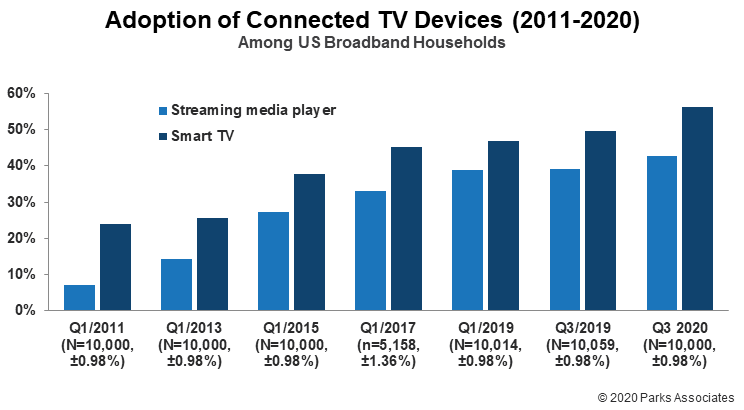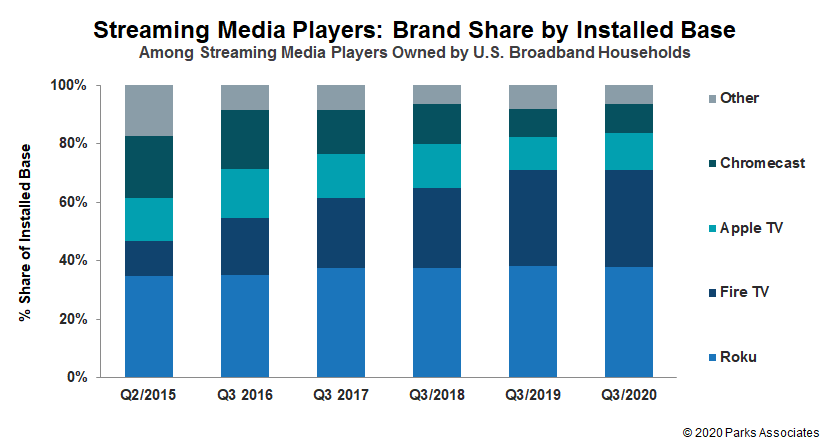Connected TV Market Update
by
Kristen Hanich | Dec. 21, 2020
As we head towards the new year, it’s a good point to look back at how the connected TV market has changed during the course of 2020. We’ve seen accelerations in the adoption of streaming video products, particularly connected TV devices such as smart TVs and streaming media players. In early 2020, retailers sold out of their existing stock as strong consumer demand ran up against factory shutdowns and delays in shipping. In the third quarter of 2020, production and shipping returned, and manufacturers reported some of the highest sales they’ve had in years.
As of Q3 2020, 56% of US broadband households own smart TVs, and 43% of US broadband households own streaming media players – aka streaming sticks and boxes. This is up from 50% and 39% in Q3 2019, respectively.

Within this landscape, the dynamics of the top platforms have also changed. Parks Associates has tracked the self-reported installed base of streaming media player brands – or the share of streaming sticks and boxes that are owned and in use in consumers’ homes – since 2015. Over that time, we have seen a consolidation in the market towards two players—Roku and Fire TV have become two of the largest names in the streaming media player space, pushing Chromecast down to fourth place below Fire TV. On the smart TV side of things, Samsung is and remains the market leader, with 42% of smart TV owners reporting that their primary smart TV is a Samsung Tizen TV model.

In terms of the shape of the overall connected TV market, it can be difficult to get an accurate and comprehensive view. The smart TV market is fragmented, with many consumers using older models with operating systems and apps that haven’t received updates in years. Data pulled from third-party frameworks may therefore not tell an accurate story. Company-reported data may also be tricky – the consumer’s home is a complex landscape. A household may have multiple TVs in different rooms, and multiple members each with their own streaming account. Smart TVs may be connected to the internet and also have a streaming box or gaming console attached. Different individuals in the home may prefer to use different devices, even if all are attached to the same TV.
In the first quarter of 2020, Parks Associates asked heads of US broadband households which connected TV product was their primary device for viewing streaming video. We then drilled down into which brand they owned and combined brands across smart TVs and streaming media players. During that time, we found that in the US market, according to our survey respondents, Samsung is the leader in the overall connected TV space, with Roku in second place, and Amazon Fire TV in third. In terms of share of online video viewing hours, Roku leads, followed by Samsung and Fire TV.
Since our earlier research, these companies have publicly released a few new numbers:
- Samsung: 100 million internet-connected smart TVs worldwide, 45 million Samsung TV households in the US (source: Samsung Ads, in an interview with TV[R]EV)
- Roku: 45 million active accounts worldwide (source: Roku 10-Q published November 2020)
- Fire TV: 50 million global monthly active users worldwide (source: Fierce Video)
Of course, these are all different measures looking at different things. A household is not the same as an account, which is not the same as a user. The footprints of these players are also different – for Samsung, more than half of their TV footprint is outside of the US. Roku is mostly inside the US. Fire TV, meanwhile, has a healthy US presence but also leads in several international markets.
Parks Associates looks forward to seeing how the overall connected TV landscape may have changed when we launch our next consumer survey in Q1 2021.
For a deeper look at the connected TV space, please check out Parks Associates Streaming Video Products: Driving Adoption.
For more information about Parks Associates research, visit http://www.parksassociates.com or call 972-490-1113.
Next: CES 2021: TV Brands Seek Differentiation Amid Competition
Previous: Connected Devices Provide New Opportunities to Extend Monitoring Services
Comments
-
Be the first to leave a comment.
Post a Comment
Have a comment? Login or create an account to start a discussion.


